Felling
Felling is the process of cutting down trees,[2] an element of the task of logging. The person cutting the trees is a lumberjack. A feller buncher is a machine capable of felling a single large tree or grouping and felling several small ones simultaneously.[2]
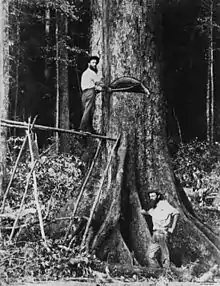
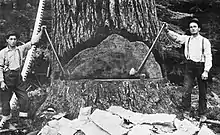
Methods
Hand felling
In hand felling, an axe, saw, or chainsaw is used to fell a tree, followed up by limbing and bucking in traditional applications. In the modern commercial logging industry, felling is typically followed by limbing and skidding.
Feller buncher
A feller-buncher is a motorized vehicle with an attachment which rapidly cuts and gathers several trees in the process of felling them.
In cut-to-length logging a harvester performs the tasks of a feller-buncher, additionally doing the delimbing and bucking. When harvesting wood from a felled tree, the recommended methods should be followed in order to maximize wood recovery. The suggested trend is to make deeper cuts and smaller openness when performing undercuts. [3]
Types of cut
The undercut or notch cut is the guiding or aiming slot for the tree and is a V-shaped notch placed on the side of the tree in the direction of intended fall.[4]
The back cut or felling cut is made on the opposite side of the tree of the undercut and is cut through the base of the tree severing the “hinge” holding the tree up.[4]
The Tongue and Groove cut is a type of cut that uses the tree as its own guide for where it will fall. This is commonly used by loggers when they need precision in their drop.
Boom-corridor experiment
This was an experiment conducted regarding felling trees and the continuous felling of trees in boom-corridors which might lead to an increase in harvester productivity. An efficient way to do this would be to use felling heads which would increase efficiency and fall time.[5]
Gallery
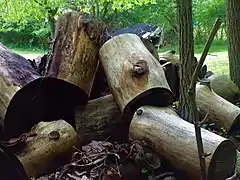 Timber logs that have been cut and stockpiled for logging.
Timber logs that have been cut and stockpiled for logging.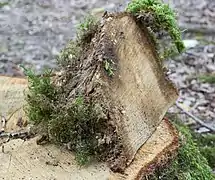 A piece of trunk.
A piece of trunk.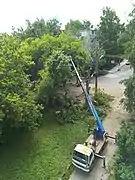 Felling in urban setting in Russia. Telescopic handler and chainsaw are used.
Felling in urban setting in Russia. Telescopic handler and chainsaw are used.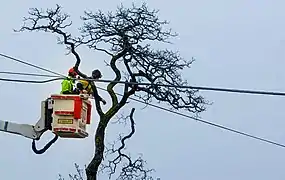 Urban felling in Australia. This is done to secure areas from accidental tree falls.
Urban felling in Australia. This is done to secure areas from accidental tree falls.- Video of tree felling, limbing, bucking, moving
References
- Johnston, Hank (1968). Thunder in the Mountains: The Life and Times of Madera Sugar Pine. Trans-Anglo Books. p. 11. ISBN 0-87046-017-X.
- "Feller" def. 2. and "Felling", def. 1. Oxford English Dictionary Second Edition on CD-ROM (v. 4.0) © Oxford University Press 2009
- Borz, Stelian Alexandru; Ignea, Gheorghe; Vasilescu, Maria Magdalena (2014-10-02). "Small Gains in Wood Recovery Rate when Disobeying the Recommended Motor-Manual Tree Felling Procedures: Another Reason to Use the Proper Technical Prescriptions". BioResources. 9 (4): 6938–6949. doi:10.15376/biores.9.4.6938-6949. ISSN 1930-2126. Archived from the original on 2020-11-25. Retrieved 2018-11-29.
- "Felling, Limbing and Bucking Trees". extension2.missouri.edu. Archived from the original on 2018-11-29. Retrieved 2018-11-29.
- Bergström, Dan; Bergsten, Urban; Hörnlund, Thomas; Nordfjell, Tomas (July 2012). "Continuous felling of small diameter trees in boom-corridors with a prototype felling head". Scandinavian Journal of Forest Research. 27 (5): 474–480. doi:10.1080/02827581.2012.663404. ISSN 0282-7581. S2CID 85271790.
